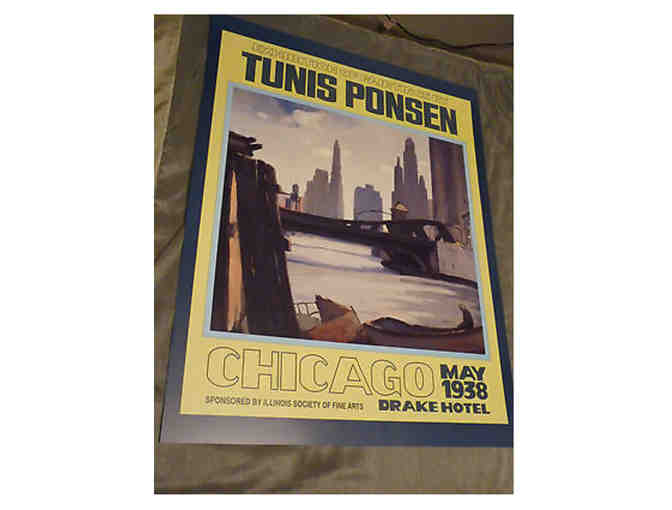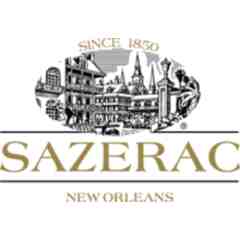Art
Rare 1938 Tunis Ponsen 22 x 28 Chicago Drake Hotel Poster
- Item Number
- 363
- Estimated Value
- 90 USD
- Sold
- 50 USD to monty617
- Number of Bids
- 5 - Bid History
Item Description
Beautiful RARE Uncirculated TUNIS PONSEN 22" x 28" CHICAGO Poster ART Drake Hotel 1938 WOW!!!!
This 1996 poster is a great piece of wall art begging to be framed. Great graphical appeal. Cheerful and Bright. This item will be an amazing addition to any room and will be enjoyed by all who see it. Perfect gift for the Chicago fan.
This poster is one of only 2000 that were printed for the Citizen's Insurance Travelling Tour of The Lost Art of Tunis Ponsen. The posters were never circulated and are a rare find.
Great item for the Art and Travel Collectors/Enthusiasts.
From Chicago Tribune:
An Artist's Amazing Legacy
Tunis Ponsen Painted More Than 1,000 Pictures, And Then Was Forgotten-except By His Niece
July 21, 1996|By Jeff Lyon.
It began prosaically enough-with a Michigan couple's application for homeowner's insurance.Included on the form they filed with the Citizens Insurance Company of America was a special request. Could the company provide fine arts coverage for 110 oil paintings and watercolors that the couple had stored in their house?
Routinely, the firm dispatched Patrick Coffey, its marketing vice president and a certified art appraiser, to evaluate the artwork. But when Coffey arrived with his wife at the home of Kenneth and Angenita Morris that fall day in 1990, what he saw took his breath away. The walls of the house were covered with the output of an extraordinary but little-known painter.
By the time Mrs. Morris opened a basement door to reveal some 1,000 more of the artist's works stacked in wooden storage racks under climate-controlled conditions, Coffey and his wife were near shock. "We both stood there in awe as though we had stumbled into King Solomon's mines," he recalls.
The treasure, in this case, was virtually the entire oeuvre of Tunis Ponsen, an important and once-celebrated Chicago regional painter whom the art world had all but forgotten. His canvases had been lovingly preserved for more than 20 years by Mrs. Morris, his niece and sole heir.
Even before his death in 1968, Ponsen had slipped into obscurity, attributable as much to his self-effacing nature as to his aesthetic conservatism in a time of de-emphasis on representational art.
But the power of his work was evident to Coffey, whose rediscovery of Ponsen has led to a posthumous renaissance for the artist (His "Chicago Silhouettes," a 1934 study of the Chicago River that City University of New York art historian William Gerdts calls a "marvelous" painting with "neutral tonalities of grey and black which lend a faint melancholy to the drama of modern architectural forms," was the cover of Chicago novelist Stuart Dybek's recent book, "The Coast of Chicago").
Ponsen's paintings are currently the subject of a major retrospective exhibition at the Harold Washington Library Center. Entitled "The Lost Paintings of Tunis Ponsen," and set to run through Sept. 1, the exhibition was organized by the Muskegon Museum of Art with support provided by Citizens Insurance. On display are 51 nudes, portraits, still lifes and landscapes produced by an artist whose work was, at the peak of his popularity, hung alongside that of Pablo Picasso at Chicago's Century of Progress Exhibition in 1933, but whose star was destined to dim.
The last significant exhibition of Ponsen's work was in 1938. He was, apart from some notable dabbling in abstraction, a traditionalist, influenced by the impressionism of Cezanne and the post-impressionism of Van Gogh.
But a kind of gritty modernism is evident in his industrial and commercial landscapes of Chicago, which he rendered with an eye similar to that of the young Georgia O'Keeffe, who was doing the same thing in New York City, and in his Depression-era visions of the rural Midwest, which he evoked with a skill reminiscent of his better-known contemporaries Grant Wood and Thomas Hart Benton.
"As we look at his oeuvre, it becomes clear that he does not simply paint beautiful images, although he often does that," notes Roosevelt University art historian Susan Weininger. "His abiding interest and commitment was to paint, like the impressionists he most certainly admired, what he saw. In the subjects he treated during the course of his almost 50 year career as a painter . . . he never strayed far from this principle. And it is the landscape, both rural and urban, that provided him with his most powerful inspiration."
A native of the Netherlands who was orphaned as a teenager, Ponsen immigrated to the United States in 1913, settling in Muskegon, Mich., where he first worked as a house painter. In 1924, he moved to Chicago to study at the Art Institute and remained here for the rest of his life, his home in Hyde Park.
Over the next 20 years he would win many prizes and his works would be exhibited in such important museums as the Art Institute, the Detroit Institute of Arts, the Toledo Art Museum and the Pennsylvania Academy of Fine Arts.
By all accounts, he was a gentle, retiring man who never married (his childhood sweetheart fell in love with another man as she sailed to America to marry Ponsen) and whose private life revolved around the Muskegon family of his sister Arnolda, whose farm is the backdrop in many of his paintings.
When Ponsen died at the age of 77, his works were willed to Arnolda's daughter, Angenita, who took elaborate measures to preserve her uncle's work, dreaming of the day when his talent would be rediscovered.
"His story reflects a classic pattern of many American artists. They have a time of high recognition followed by eclipse," says Ingrid Lesley, chief of the special collections and preservation division at the Washington Library. "But he deserves to be rediscovered. This is a spectacular show."
In 1932, Ponsen received the only national recognition of his career when he was reviewed by the Christian Science Monitor., which called him "an artist's artist." He told a Monitor interviewer:
"You know, I just paint the thing I see the way I feel it. I have no particular theories. I just try to paint well."
Item Special Note
*Item must be picked up from Our Lady of Mount Carmel Academy.
Donated By:
Ted's Sports Cards and Collectibles
Our Lady of Mount Carmel Academy stores data...
Your support matters, so Our Lady of Mount Carmel Academy would like to use your information to keep in touch about things that may matter to you. If you choose to hear from Our Lady of Mount Carmel Academy, we may contact you in the future about our ongoing efforts.
Your privacy is important to us, so Our Lady of Mount Carmel Academy will keep your personal data secure and Our Lady of Mount Carmel Academy will not use it for marketing communications which you have not agreed to receive. At any time, you may withdraw consent by emailing Privacy@frontstream.com or by contacting our Privacy Officer. Please see our Privacy Policy found here PrivacyPolicy.










 The Glaser Family
The Glaser Family




 DePaul College Prep
DePaul College Prep



